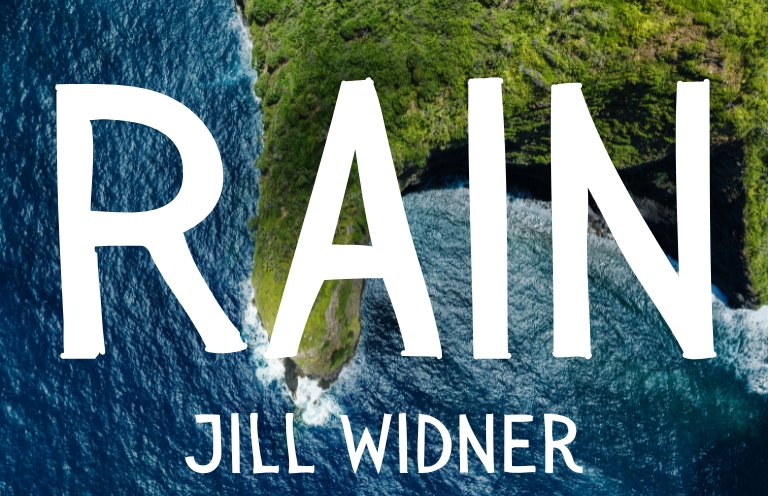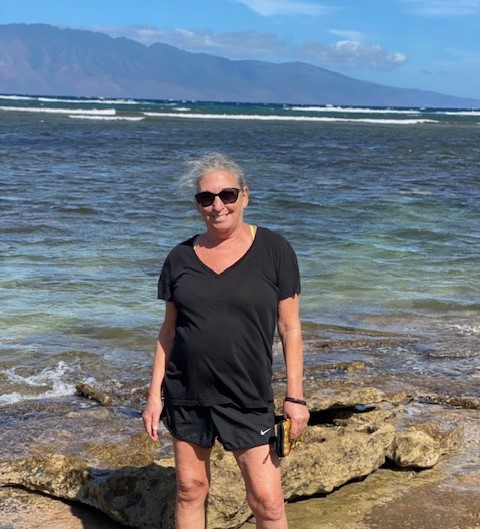Jill Widner’s “Rain,” steeped in sensory details, is both a snapshot of a stormy wait in a commuter terminal and a love story to Hawai’i. The details of the wait accumulate with force: a zipper tab like a miniature pin cushion, cars that look like they’ve been electrocuted, a lip jutted against a Velcro closure. As the story unfolds, the longing for home becomes more and more acute.

The terminal for the commuter airline that services the island is cinder block. It’s raining and the cold damp air seeps into the room through the moldering mortar. The ticket agent, an older Filipina woman, lifts a hard-sided, insulated cooler marked deer meat from the scale to the floor behind the baggage counter. The flight back to Honolulu is delayed because of fog.
Yvette is asleep in her chair. I reach beneath the chair for the notebook I keep in my pack. I like the pull tab attached to the zipper. The way it feels like a miniature pin cushion between my thumb and forefinger. White thread embroidered on a red patch. A mountain resting inside the lip of a wave about to break.
I had thought I would begin the article with a geologist’s physical description of the island. I had already transcribed an excerpt from a geographical survey I’d found in the library:
Lāna’i lies 59 miles south of Honolulu. It has an area of 141 square miles, and is 3,370 feet high… The surface above 1,200 feet is generally covered with lateritic soil, which reaches a maximum depth of 50 feet. Below this level the island is devoid of vegetation and is strewn with boulders, the result of having been once submerged by the ocean to this depth…[i]
I uncap my pen and strike through the paragraph. I look at my watch and, on a new page, painstakingly print the year, the date, and the time in the top left corner.
The rain is falling harder now. I like the sound it makes striking the tin roof. I stare through the glass door at the trucks in the parking lot. At the top of the page, I write the word continued and, above that, underlined, as though it were the name of a species, the place name Lāna’i:
Whenever I had the chance, I sat in the co-pilot’s seat. Over the pilot’s left shoulder, Moloka’i; ahead of the nose, Lāna’i; in between, turbulence. I liked the cuttering sound of the propellers, and I liked looking down, the tiny Cessna, bucking along, not more than a thousand feet above the white caps blowing back across the Moloka’i Channel.
In time, I began to recognize the coastline of Lāna’i. The long barren beach across the north end. The rocky outcrop of tumbled boulders along the northwest corner. The wall of cliffs that marks the tucked-in waist of the island. In time I learned the place names. Polihua. Palahinu. Nānāhoa. Kaumalapau.
It was always loud coming in, and the fuselage always reared, crossing the cliffs. The wings wavered, descending over the pale green fields as the pilot’s hands moved over the instruments. The gears shifted; the wheels dropped down. Through the cockpit window, acres and acres of pineapple, planted in elliptically shaped, cultivated plots, rolled with the slope of the land to the horizon. Out of nowhere, a short strip of asphalt appeared. White lines marking the runway rushed forward. Pheasants skittered out of the way as the wheels touched the ground. There was a kind of exhalation as the engines shut down. Then the pilot was unfolding the door into a flight of stairs, and I was breathing the shock of cold air that, for me, was always Lāna’i.
I hear what sounds like sheet metal banging overhead and look to the ceiling, thinking a piece of the roof has come loose. No one else in the waiting room appears to be concerned. The fluorescent tubes hanging from the ceiling flicker, and then the glass in the door is illuminated by sheet lightning. One moment I am looking at my reflection in the black surface; the next, I can see through the glass. For a split second the trucks and cars in the parking lot light up as if they’ve been electrocuted. Thunder follows and tension scatters like ball bearings spilled across the floor. I cup my hands to the glass. Most of the leaves have blown down from the plumeria trees. The branches shake in the wind. A few white petals cartwheel across the lawn. I smell ozone, or what I think of as ozone. The smell of rain. I want to be outside.
The sidewalk is protected beneath the eaves, and I find a place to stand close to the wall. The rain sounds louder outside, clattering on the roof and gushing through the gutters.
My jacket feels stiff zipped closed. The collar chafes my chin. The sleeves are cold and damp against my arms. I walk beneath the eaves to the end of the sidewalk, my lower lip jutted against the Velcro closure. The back of the building faces a locked gate in a chain-link fence. Rain has begun to accumulate on the runway.
In the distance, fog moves down from the mountain and across the pineapple fields toward the landing strip. Rain pelts the top of my head through the skin of my windbreaker. Not fog. Noe. Not mountain. Hale. I lift my face and sniff at my fingers, caked with clay, and open my mouth to the rain.
[i] Anderson Duane Black. Lāna’i: The Elusive Hawaiian Island–the One that Captain Cook Missed. New York, Vantage Press, 2001.

“Rain” is an excerpt from Before the Rain, a novella-length collection of interconnected vignettes, set on the island of Lāna’i, where Widner lived and taught in the early 80s when it was a pineapple plantation.
Her chapbook A Middle Eastern No was selected as the international winner of the inaugural Southword Fiction Chapbook Competition and published by the Munster Literature Centre in conjunction with the Cork International Short Story Festival in Cork, Ireland.
Her fiction has also appeared in American Short Fiction (web exclusives series), Asia Literary Review (Hong Kong), The Fiddlehead: Atlantic Canada’s International Literary Journal, Kenyon Review Online, Kyoto Journal (Japan), North American Review, Shenandoah, and elsewhere.
Her work has been supported by grants and fellowships from Artist Trust and the Washington State Arts Commission, Hawthornden Castle (Scotland), MacDowell, the Virginia Center for the Creative Arts, VCCA-France, and Yaddo. She is a graduate of the University of Hawai’i at Manoa and the Iowa Writers’ Workshop and currently live in Yakima, Washington.
